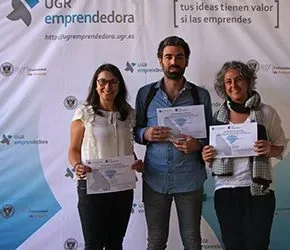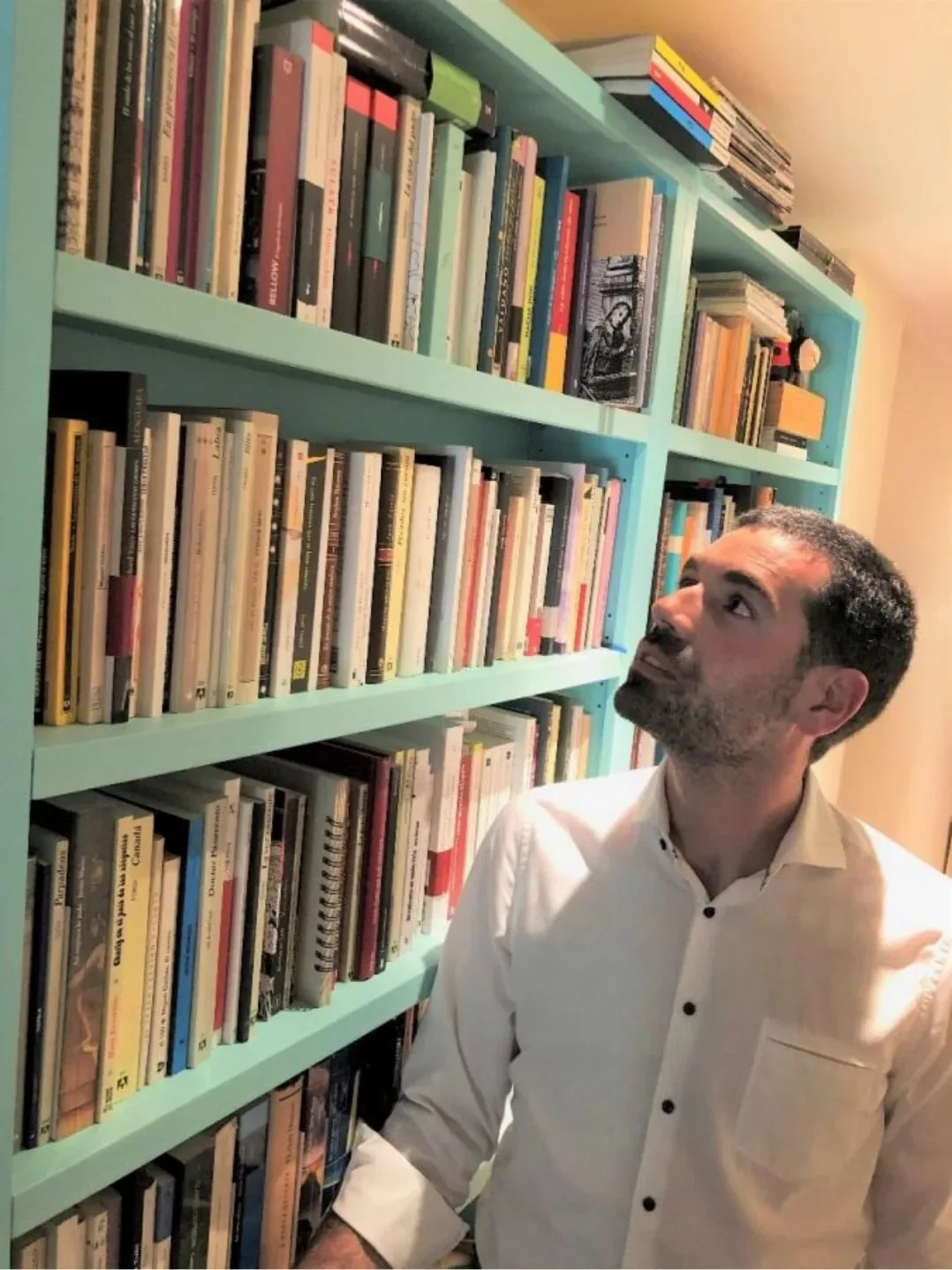
TESELA wins 3rd prize in the VI University Entrepreneurship Competition 2016


Written by Sara Mariottini, Entrepreneurship and Communication Technician
Since 2016 Tesela has carried out more than 20 major projects, most of which are related to national historical heritage. For its second year participating in Alhambra Venture and today we have the pleasure of sharing this space with the company’s CSO, Eugenio Navarro. Eugenio is an eclectic entrepreneur who has found a way to unite his passion for materials chemistry with artistic heritage. He is a scientist, a passionate philosopher and also a writer… What else? Let’s discover their story together!
3 adjectives. How do you define yourself as a person and an entrepreneur?
Enthusiastic, Creative and Collaborative.
Before founding the company Tesela with Professor Eduardo Sebastián Pardo and Ana ArizziYou worked for more than 15 years in a building products manufacturing company. Tell us a little about yourself, your studies and what led you to become an entrepreneur.
I remember myself as a curious child in many ways, who was always powerfully drawn to two things: books and finding out what things were made of. This duel was always so strong that until the last minute I was deciding whether to study philosophy (my great passion) or chemistry (what I finally did). I believe that true entrepreneurship is rooted in an ancestral need for knowledge and personal development that goes far beyond economic or market interests. I was fortunate enough to start working almost as a graduate in private industry, which gave me the opportunity to develop not only as a professional, but also as a person, which is something I am always grateful for. This did not prevent him from gradually collecting a series of ideas and projects that had no place within the company. Over time I ended up living with a nebula of ideas that continually swirled around in my head and that I found impossible to avoid. The way I found to make them a reality was to take the leap into entrepreneurship, founding TESELA, together with Eduardo and Anna, who, like me, also had ideas and projects that had no place in the university environment or not in a professional way. Often, in order to become a reality, what companies need is the right medium. All we did was set the conditions for them to grow.
Tesela was born in 2015. What values, mission and vision does this name embody?
TESELA’s vision is to be a scientific and technical partner of reference in the field of materials in general and in those concerning Heritage in particular, for all those actors involved who want to implement innovative and sustainable solutions, acquiring a commitment to transparency, social and environmental responsibility with society.

Our mission is to care for heritage by adding value at all stages of the intervention through knowledge and specialised technical advice. Today’s society is changing at a dizzying pace: it is asking for a change when one has already taken place that was not foreseen. The capacity of people and companies to adapt and respond is tested day after day, and to the extent that we know how to respond to this, we will either grow or we will not. At TESELA we aim to redefine the meaning of business success by using the power of knowledge to generate inclusive, regenerative and social value that allows us to move forward without forgetting the steps we took and that others took for us.

As time went by, your company opened up many business opportunities in the market. Tell us a little about the company’s history and its customers.
TESELA was born with the UGR spin-off licence under its arm and an inevitable marked scientific and teaching character linked to the research of (construction) materials and particularly those related to Heritage works. This was really the work that we inherited from Eduardo’s university days and which gave meaning to the company in the first place, and which five years later is still our most precious pillar. But it is true that today TESELA’s perspective is much richer and broader, and our lines of business have branched out into new horizons such as new materials, sustainability, the use of waste, or the recovery of mineral resources, bringing together our own and other people’s initiatives, always with a collaborative and inclusive spirit. Our priority is to provide the best possible service to our clients, and if this requires the collaboration of other professionals and companies, we do not hesitate to establish working relationships with them. This past year we have also launched a Quality Seal for materials that are incorporated into Heritage works, such as lime, lime mortar, bricks or wood, an initiative that was born, among other reasons, from the verification by the institutions of the poor performance that many materials offered on site despite their compliance with the legal minimums established by the Construction Products Directive through what we know as the CE marking. We are also present in associations such as AFAM, ANFAPA, we are founding members of CAL (Andalusian lime cluster), of the PTI-PAIS Open Heritage platform of the CSIC, where we offer our knowledge of raw materials, additives, product development, characterisation of materials, preparation of intervention projects, analysis of pathologies… without forgetting the teaching and training work we do for the University of Granada itself and the various courses, seminars, congresses or the university master’s degree in Science and Technology of Heritage CitPa.
Thus, almost without realising it, the company has internationalised, with the last year being a key year in this respect, given that almost 40% of our income comes from abroad, where we work in countries such as France, the United Kingdom, Belgium, Italy, Morocco, Algeria and Saudi Arabia. The profile of our clients is very heterogeneous and ranges from state administrations and town councils to private individuals, museums, application companies, material manufacturers, raw material extractors, chemical additive distributors, laboratories, architectural studios, etc.

Art and Science are two paths that meet in many profiles of people who have left a mark on the history of humanity, such as Leonardo Da Vinci and Salvador Dalí. You chose literature as a form of artistic expression. Why?
Dostoyevsky, Kafka, Ernesto Sábato… there are many cases of scientists who ended up making a literary career for the good. I don’t think that’s my case any more (laughs), although when you’ve been inoculated with this poison there’s not much you can do about it either. I read a lot and write little, it must be said. And what little I do engage in is more unsatisfactory than productive, but alas! What would I do without it! It is the best tool I have found to express myself, or at least the one that brings me closer to my fellow man, which is what this is all about. The other way is science, the laboratory, in which I enjoy and suffer as much as I do writing; the way of reaching out is perhaps more impersonal, but equally effective, and its artistic side, often reviled, is not to be disdained, and which connects with an age-old creative endeavour.
To date I have published three collections of poems, the latest in 2014 entitled “Puertas de atrás” (Sorel & Bascombe ed. Literarias) in which I try in some way to alleviate, if not almost to vindicate with an Olympic spirit, the figure of the loser in the face of the pressing social reality in which only the number one, the winner, is given a place, circumscribing success to that alone. I am currently working in the genre of storytelling and narration, where I seem to have found the most suitable suit to express myself.
When and how did you find out about UGR Emprendedora?
TESELA has an office in the Technology Transfer Centre (CTT) where the Research Results Transfer Office (OTRI) is located, which also houses central and ancillary services such as marketing, intellectual property management, administration, etc. These services are of vital importance as consultants, especially in the first phase of a company’s growth. It was there that we got to know UGR Emprendedora.
Given your experience, what are the mistakes that have taught you a lot and what would you advise not to make when starting a business?
In these 5 years we have done a lot of things right and a lot of things wrong. In life we make mistakes all the time, and the only thing that allows us to move forward is to make them right again and again. And we have done that too. We have been able to learn what we didn’t know, to improve what we already did well and not to do again what we once did badly. If I had to give one piece of advice, it would be related to people, to try to choose the right companions along the way, both in terms of the company and in the form of customers and suppliers. The people you travel with manipulate your compass too, and it is worth stopping, studying, reflecting, asking questions, investigating until you find the right companions.
What opportunities are there in your sector?
The materials sector is constantly advancing because science does not stand still and every day new raw materials appear and we have access to new advances that allow us to be more competitive. Everything can always be improved in terms of quality or price or energy efficiency… and in this sense, the use of waste and by-products from industry and their recovery is one of the most interesting and promising avenues of work we are working on, which brings us fully into the paradigm of the circular economy and environmental sustainability.
What types of profiles would help you to grow as a company?
It is very clear to me that people are what make companies, so our employees are our main asset, and taking into account the broad scope of the business towards which we are moving, it is more important than their qualifications that they have a profile with initiative, that they are dynamic, eager to learn and to contribute knowledge and value to the company and to our clients.
How do you see yourself with the company in the next three years?
Hopefully, this time will be enough for TESELA to have positioned itself as the reference company and leader in the study of materials for Heritage, and that on the other hand, we have sufficiently developed the other business legs so that each one functions almost independently. In any case, I look forward to continuing to enjoy my day-to-day work at the helm of the company. That will be a good sign that everything is going well.
One week before the Alhambra Venture 2020 event: what expectations have led you to participate, what are you looking for as a company?
This is our second participation in this event. For research companies like ours, private funding is a resource that we cannot lose sight of, as we have our own know-how that can bring a lot of value from zero time to the interested private company. But on the other hand, I do not want to miss the opportunity to make an appeal for governmental funding tools to finally support innovative projects of value and for them not to be cut off from the financial side at the drop of a hat. It is also a political responsibility to find ways to bring these projects to fruition in order to increase the country’s innovative efficiency.
A piece of advice to the people who read us and who have this concern for entrepreneurship?
Believe in yourself, in your ideas and always trust your intuition.